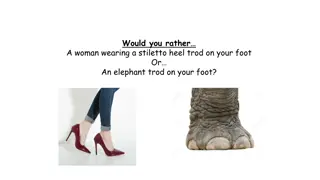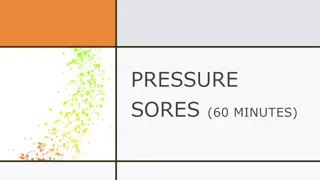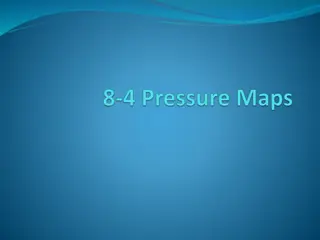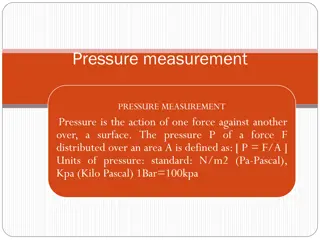Understanding Pressure Groups and Their Influence on Decision-Making
Pressure groups are formed by like-minded individuals to influence decision-makers by drawing attention to specific issues, with the aim of impacting legislation and existing laws. People join pressure groups seeking to address particular issues more effectively than through mainstream politics. While some view pressure groups as enhancing democracy, others see them as a threat. These groups can vary in size and approach, from local protests to multinational campaigns, and may have both short-term and long-term aims.
Download Presentation

Please find below an Image/Link to download the presentation.
The content on the website is provided AS IS for your information and personal use only. It may not be sold, licensed, or shared on other websites without obtaining consent from the author. Download presentation by click this link. If you encounter any issues during the download, it is possible that the publisher has removed the file from their server.
E N D
Presentation Transcript
What is a pressure group? A pressure group is a group of like minded people who want to influence decision makers. They aim to do this by drawing attention to specific issues. They ultimately hope to influence large organisations/the government and hope to make an impact on the formation of legislation and amendment of existing laws.
What is a pressure group? They feel they have more success in pressuring government as a group rather than individuals. They can vary in size from a small group of locals protesting about a local issue to multinational organisations protesting a global issue.
Why do people join a pressure group? Pressure groups do not usually want to be in government or mainstream politics they only have an interest in a particular issue and find political parties not an attractive prospect. Pressure groups offer a narrower and more specific focus, usually on a single issue that can seem more important and more appealing to many. We have seen a movement away from political party membership to pressure groups in recent decades.
Why do people join a pressure group? Since the 1960s political party membership has steadily decline, at just over 1% of the population, the UK ranks lowest in Europe. Many have suggested this is due to- Lack of interest in politics Lack of trust in politicians Many see Pressure groups as more honest and accessible.
What are the aims of pressure groups? Some argue that they enhance the democratic process others argue they threaten democracy. Many pressure groups have a specific set of aims. There are many short-life pressure groups which are usually locally organised and want to influence about an issue that affects local communities.
What are the aims of pressure groups? Other pressure groups have aims that will not be met in the short term. Read the following examples of pressure groups. These groups tend to be more disruptive in their methods and at times will conflict with democratic process. Take notes on What they were protesting How they protested Whether they were successful Are they seen as legitimate and why?
Cause groups These have a shared belief or view and are set up to promote a specific cause in which members have an interest. Key feature is anyone can become a member. As long as you have an interest in the cause and can participate fully. Can exist for a short period or over the longer term.
Sectional groups These are set up to represent and promote the material interests of a specific groups of people. Cut and stick in the following pressure groups under the correct heading. They are only interested in the needs of their members only. The most popular form of sectional group is a trade union, which looks after the interest of workers. Cause Group Sectional Group
Insider Pressure groups These groups work with the government with the hope of persuading them to address their cause. In order for this to work they need to carry out their campaigns in a professional and organised manner. Likely to campaign through organised meetings and events and may, in fact have the ear of the government as they are consulted by decision makers.
Insider Pressure groups Normally represent professional bodies such as law and medicine. As a result often regarded as experts in their fields and can in fact be seen as key stakeholders in drafting legislation. Many of these pressure groups are not well known to the general public as they will often seek change behind closed doors in areas that may not be seen as particularly newsworthy. There are limits to the influence, especially if they disagree with government policies.
Outside Pressure groups Many find themselves forced to challenge and at time disrupt the work of government. On many occasions they will act out in public to try to draw attention to their cause. At times this can even become destructive, chaotic and violent, resulting in law-breaking and arrests. This means they usually have a negative relationship with the government and will be excluded from policy making.
Outside Pressure groups It is this exclusion that can lead many groups to take direct action as they feel that their concerns are not being noted by decision makers and so they have to pressure them by bringing publicity to their issue. Owing to the very public nature of their protests, they often have a much bigger public profile and be covered more prominently by the press.
Insiders Outsiders Are compatible with government Cut and stick in the following pressure groups under the correct heading. Are incompatible with government Are regularly consulted by the decision makers Are not regularly consulted Work with the government Engage in directs action and civil disobedience to put pressure on the decision makers Insider Group Have privileged status Are not seen as having useful expertise or objectivity Outsider Group Have expert knowledge Usually campaign on controversial issues
How influential are pressure groups? The extent of a pressure groups influence is heavily dependent upon a number of factors: Their relationship with the government (discussed earlier) The group aims and context The group status and access Methods The group s resources
Group aims and context If their goal is seen as unachievable, open-ended, expensive or global than it becomes harder to recognise their success. For example the Campaign for Nuclear Disarmament (CND) hopes to achieve worldwide ban of nuclear weapons. They have been campaigning for decades and likely to continue. They may argue they successful for bringing the issue to public conscience but they are unlikely to ever fully achieve their goals.
Group aims and context Smaller groups with more achievable aims can be fully successful. For example, Tripping up Trump protested about Trump expanding his golf resort. They argued that the land deserved to be protected. One way they were successful was by acquiring land around the site, so restricting Trump s planned expansion.
Group aims and context Groups whose aims have a large support among the public and legislators more likely to be successful. For example, Jamie Oliver s Feed Me Better campaign received a lot of public backing unlike National Association for the Care and Resettlement of Offenders.
Group aims and context Various issues drift in and out of public debate and if timed correctly pressure groups can have great success. For example in the 1970 s Friends of the Earth struggled to gain influence but as the effects of global warming have become apparent they may see attitudes towards their aims have changed and result in more success.
Group Status and access If they are an insider group more likely demands will be met by the government. For example, The Confederation of British Industry (CBI) represents the interest of thousands of businesses across the UK. Its often a key stakeholder in the formation of government policies relating to business. At the CBI 2014 annual conference David Cameron was the key note speaker. CBI claimed success in persuading the government to stick with zerohour contracts.
Methods If they feel that it has a strong influence, it will probably be prepared to keep its actions low-key and more conventional; if it feels it has little influence then it may publically protest in a legal manner-this is known as direct action. The more public their methods are the more likely it will become an outsider group. They need to be careful they don t become disruptive or break laws and use illegal methods as they are highly unlikely to be successful.
Many commission studies and reports to boost cause. Joseph Rowntree Foundation commissioned many studies on negative impact of Tories austerity cuts Well organised and peaceful marches often used to build public support. These can be found via the government s official petitions website and other independent petition websites, such as change.org Petitions Research In 2003 Stop the War saw 2 million people march through London Success stories include the Gurkha Justice Campaign Conventional Methods Letter- writing campaignsOften used by Marches This method was used very successfully by the Gurkhu Justice Campaign Lobbying human rights groups Amnesty International encourage visitors to their website to write in support of individuals who have had their human rights infringed. Groups will set up meetings to persuade politicians to join/support their cause
Surfers against Sewage attracted media attention by posing for pictures wearing gas masks and sitting on toilets on the Beach Student protests against tuition fees in London turned violent. Windows were smashed, Prince Charles car was attacked and more than 50 people were injured. In Nov 2015 anti-capitalist Million Mask March by Anonymous ended violently with more than 50 arrests for assaults on police officers. Legal stunts Direct Action In early 2000s oil refineries were blockaded in protest at high fuel taxes, causing fuel shortages. Gov been reluctant to increase since. Violent illegal Activity Blockades/ occupying areas In Scotland the bairns not Bombs protest in April 205 blockaded entrance to Faslane Naval Base in attempt to close down base. While illegal it was successful and closed base for 1 day. In 2012 the immediate area around St Paul's cathedral in London was used as a camp for nearly two months by anti-austerity protestors.
Group resources The human resources such as size of membership and the skills available to the group can determine success. The finances and equipment available can have a huge effect on their impact. Groups that benefit from a sizeable memberships such as the RSPB (more than 1.2 million) will get attention from decision makers and will benefit from greater finances. Although smaller groups are using crowdfunding websites to generate funds.
Group resources Groups that possess the kind of skills the group needs will have an advantage over others. For example it is claimed that middle class groups are often successful because they benefit from well-educated and articulate membership. Cut and stick in the advantages and disadvantages of pressure groups. Celebrity endorsement gain influence as attract media coverage. For example Emma Watson s work promoting gender equality for HeForShe























